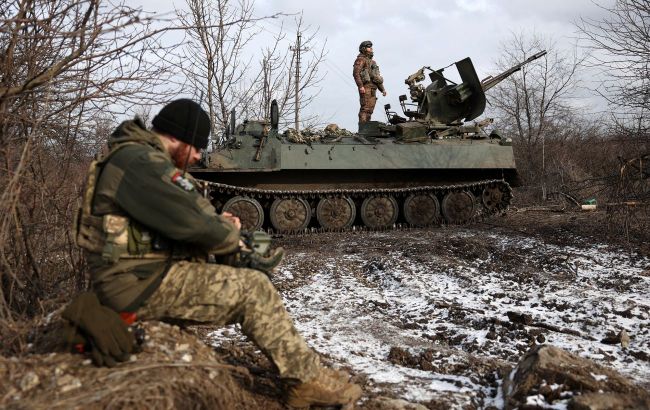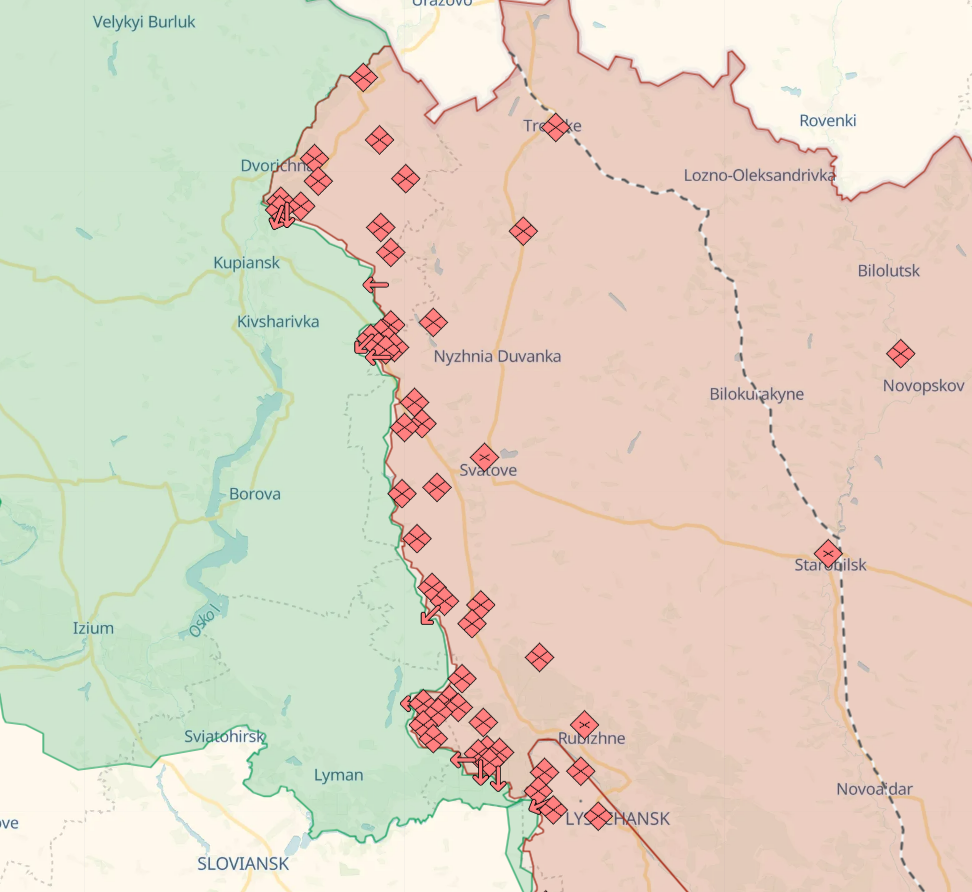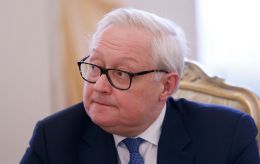Russia's advance and Ukraine's defense: What lies ahead on frontline in spring
 Photo: The Ukrainian army may be on the defensive for the next few months (GettyImages)
Photo: The Ukrainian army may be on the defensive for the next few months (GettyImages)
Russia is conducting offensives along the entire frontline. Ukrainian Armed Forces Commander-in-Chief Oleksandr Syrskyi says that the Ukrainian army is moving to a defensive operation. How the events at the front will develop this spring and whether the Ukrainian Defense Forces can launch a counteroffensive - read in an article by RBC-Ukraine.
Sources used: The New York Times, Deep State Map, comments by Oleksandr Kovalenko, a military and political observer of the Information Resistance group, and Ihor Romanenko, former Deputy Chief of the General Staff of the Armed Forces of Ukraine, as well as conversations with interlocutors in the special services on condition of anonymity.
Since the end of last year, Moscow has been conducting offensive operations along the entire 1,500-kilometer front line. Analysts and observers agree that the initiative is now on the Russian side. Since December, the enemy has captured the city of Avdiivka and several other smaller, destroyed settlements. And given the dynamics of the fighting, the enemy does not intend to stop.
The Ukrainian army has been in perhaps its most difficult situation since the summer of 2022. The stocks of ammunition at our disposal are dwindling, the occupiers' attacks in different directions make it difficult to maneuver reserves, and the vague prospects for US support do not give us an understanding of what resources we will be able to operate with.
Shortly before his appointment, the new Commander-in-Chief Oleksandr Syrskyi noted that the Defense Forces were moving from offensive to defensive operations. And this is, after all, the main plan of action that the Ukrainian troops will face at least until the end of spring - defense.
"There will be no surprises on our part - it will be mainly defensive combat operations. This will be a defensive tactic that will force us to adapt to the conditions of acute shortage of ammunition and Russian dominance in terms of the number of personnel, mechanized components, and in the air. Our society should be prepared for the fact that this tactic also implies withdrawal from certain locations if the situation there becomes critical," predicts Oleksandr Kovalenko, a military and political observer at the Information Resistance group.
According to Ihor Romanenko, former Deputy Chief of the General Staff of the Armed Forces of Ukraine, this defense operation will have three key tasks. First, it is to stop the enemy's advance. Secondly, to destroy as much enemy force and equipment as possible. And the third is to try to gain time to accumulate forces. It means to complete this defensive operation and, if appropriate resources and reserves are available, to organize a new operation to liberate our territories.
Directions of main battles
The Russian occupation army, from Kharkiv to Kherson regions, is conducting an offensive in the form of a "spread-finger" attack - simultaneously advancing in different, not always interconnected directions. Unlike concentrating forces in one area, this approach does not lead to a rapid breakthrough in defense. The Russians have already tried this approach during their winter offensive last year. But given Ukraine's lack of ammunition and reserves, the enemy is now gradually pushing forward.
According to intelligence sources, the Russians' goals and plans for the near future include reaching the administrative boundaries of Donetsk and Luhansk regions, consolidating their hold on the barrier along the Chornyi Zherebets River in the Kharkiv region, and regaining the territories liberated by Ukrainian troops during the summer and fall campaign last year.
 The Ukrainian army conducts a defensive operation (photo: GettyImages)
The Ukrainian army conducts a defensive operation (photo: GettyImages)
One of the latest "victories" of the Russian occupiers was the capture of Avdiivka, which has been located near the contact line since 2014. The occupation of this settlement cost the Russians thousands of soldiers. However, the huge losses did not force the enemy to stop and take a break - they continued to advance to the West. In recent days, the enemy has captured the village of Lastochkine, and the situation in Stepove, Orlivka, and Severne is difficult.
"In the area of Avdiivka, until recently, we had a kind of an insertion into the territory controlled by the enemy. After capturing this settlement, they managed to level the front line and free up forces. The length of the combat line has decreased there, and their offensive front has shrunk. Another problem is that the terrain to the west of Avdiivka is lower. Therefore, it is more convenient for the enemy to attack our defense lines," retired Lieutenant General Romanenko explains.
Another area where the Russians are already becoming more active is in the Zaporizhzhia sector, near Robotyne, which was de-occupied by the Ukrainian Defense Forces last summer. There, the enemy is also trying to cut off our penetration into their positions. Moreover, the return of this territory will have a significant psychological and informational effect on the enemy. The Russians periodically break through to Robotyne, but our military has so far managed to clear the village almost immediately.
The difficulty of this area is its location below the nearest occupants' positions. Recently, the enemy units operating in the Zaporizhzhia-Orikhiv direction were transferred to the subordination of the Russian Dnepr Group, which had previously operated in the Kherson region, near the administrative border of Crimea. This group now totals up to 130,000 troops.
Another task that the Dnepr group has and will continue to face is the "clearing" of the Ukrainian bridgehead on the left bank of the Kherson region near Krynky. This is a swampy coastline that rests on the Konka River. A relatively small number of Ukrainian troops are operating here, supported by artillery and drone operators from the right bank of the Dnipro River.
Even though Russian Defense Minister Shoigu has reported to Vladimir Putin several times on the capture of Krynky, the Russian occupiers have not yet succeeded in pushing our troops out of there. It also does not seem possible for Ukrainian troops to expand the area of the controlled bridgehead. Russian aviation is constantly firing at Krynky. Enemy drones attack boats that provide logistics for the Ukrainian group. The delivery of armored vehicles and other heavy equipment to the left bank is extremely problematic for us.
At the same time, Russian troops continue to exert pressure in the Bakhmut sector, trying to break through to Chasiv Yar, the Siverskyi Donets-Donbas canal, and push Ukrainian troops back from Klishchiivka and Andriivka. These are the two settlements that the Ukrainian Defense Forces were able to take last year. The enemy's offensive around Bakhmut began immediately after they managed to stop the Ukrainian army's advance south of the city. Our advantage here is that the positions of the Ukrainian Armed Forces in Chasiv Yar are on high ground.
The situation in the Maryinka sector is escalating, where the enemy is fighting to the south in Pobeda and Novomykhailivka. Offensive actions here should be seen as part of a plan for a new offensive on Vuhledar. Previously, the enemy has already made at least two significant and unsuccessful attempts to attack this city from the south. Now it probably intends to approach it from the north as well.
"They do have intentions to launch a new wave of offensive on Vuhledar. But to do so, they need to create the right conditions to close Vuhledar not only from the south but also from the north. It is unlikely that they will succeed in doing so through Novomykhailivka or Pobeda. Most likely, they will try to break through to road 0532 in the direction from Solodke to Vodiane. On the other hand, they will need to align their flanks to do so, so it is unlikely they will succeed soon," Kovalenko suggests.
About a week ago, the Russians resumed active offensive actions in the Lyman sector, where it wants to reach the banks of the Chornyi Zherebets River. Here, the enemy is acting in the direction of the villages of Terny, Yampolivka and Bilohorivka. All Russian attacks in this area can be seen as part of a larger plan to push Ukrainian units to the south beyond the Siverskyi Donets River and the west beyond the Oskil River.
 The Oskil River from Kupiansk to Sviatohirsk, the Siverskyi Donets River - perpendicularly (map: DeepState)
The Oskil River from Kupiansk to Sviatohirsk, the Siverskyi Donets River - perpendicularly (map: DeepState)
For the same purpose, the Russian occupiers are trying to put pressure on the Kupiansk direction with varying success. Kupiansk itself is located on two banks of the Oskil River and is an important logistics hub for our troops defending the eastern part of the Kharkiv region. At least since last fall, the enemy has been conducting alternate attacks from the northeast and southeast of the city. It seems that the enemy is now amassing forces in this area again for a new wave of attacks.
What's next
Most likely, in the coming months, the Russians will try to attack all of these areas, but they do not have enough forces to conduct focused attacks on each of them simultaneously. Therefore, the enemy will "feel" for weaknesses along the entire contact line and push through. According to Kovalenko, Russia's priority may be the so-called Robotyne ledge, Krynky, Bakhmut, and Avdiivka directions.
"After that, they will be able to reallocate resources to other areas, and most likely it will be either the Lyman direction or the reinforcement of a group of troops in the Kupiansk direction. However, they will be able to intensify the offensive on Kupiansk and Chasiv Yar only after the elections in Russia and mobilization. And only in the fall will they have sufficient resources to attack these settlements," the expert suggests.
RBC-Ukraine's intelligence sources make a cautious prediction that peak attacks by the Russians will continue at least until Putin's presidential election in mid-March, as the Kremlin needs to show off some achievements on the frontline before the election day. And in the second half of spring, the enemy's intense offensive actions may decline.
After the election, when Putin is no longer constrained by fears of popular discontent, he may return to the idea of a new wave of mobilization. Currently, through the use of contract soldiers and covert mobilization, Russia manages to recruit about 30,000 men for the war every month. This number is not fully sufficient to replenish losses and form reserves. However, if a decision is made to start a new mobilization, the inflow of troops to the front will be felt only in the summer and fall.
"If we talk about the situation in the spring, the enemy will conduct a strategic offensive operation, and Ukraine will conduct a strategic defense operation. Further actions will be determined depending on the available forces. The Russians have a goal to move as far as possible before the presidential elections in Russia. They do not yet have the forces for strategic actions, but they have enough for tactical ones. Our capabilities will largely be determined by the amount of Western aid we receive," Romanenko says.
 The further course of the war will primarily depend on Western aid and funding from the United States (photo: GettyImages)
The further course of the war will primarily depend on Western aid and funding from the United States (photo: GettyImages)
By the end of spring, the fate of military aid from Europe and, above all, from the United States will be clear. Until then, however, the shortage of weapons and ammunition may be the biggest challenge Ukraine faces. By March, the European Union will be able to deliver only 520,000 of the promised one million shells to Ukraine.
Czech President Petr Pavel recently said that he had found a source of about 800,000 more shells for Ukraine, which could be delivered in a matter of weeks. However, this solution requires funding, which the Czech authorities have already begun to search for. It is likely to involve purchasing ammunition outside the EU.
Meanwhile, the issue of funding from the United States, Ukraine's main donor, is still in limbo due to the upcoming presidential election. Any forecasting and planning of the military campaign for 2024-2025 largely rests on the issue of American support. Interlocutors in the military and political circles have different assessments of the prospects for reaching an agreement on the Ukrainian issue in the United States by November. The answers range from "50/50" to "they will get it in the spring."
Depending on further US funding, events at the front may develop according to three generalized scenarios. If Congress votes to allocate $60 billion in aid, the Ukrainian army will be able to conduct effective defense in the first half of the year and begin preparing its counteroffensive operations in the second half. If the aid is allocated later, Ukraine will spend the whole of 2024 on the defensive.
The least clear is if Congress fails to allocate any funding before the November elections. The policy of Donald Trump, who has every chance of becoming the next president of the United States, toward Ukraine is still a mystery. He can either force the aid after his election or put an end to it and insist on peace talks.
"The resources we are currently receiving will allow us to defend ourselves throughout this year. Depending on the level of adaptation to the limited resources, we will be able to hold out until the end of the year with the available supplies. But we will have to leave certain positions. If we get more aid, we will be able to conduct more effective defense. However, to conduct counteroffensive actions, we need to increase aid to at least the level of 2022-2023, but this is possible if the United States finally "returns to the family," Kovalenko predicts.
He adds that European countries that are actively building up their defense industry can partially compensate for the lack of American aid. In addition, other countries in the world have not yet used their potential to help Ukraine.

